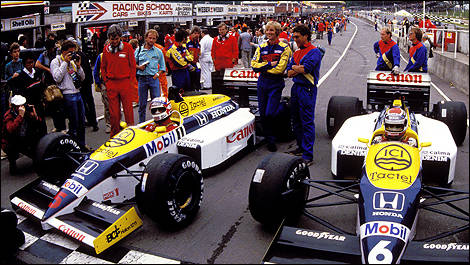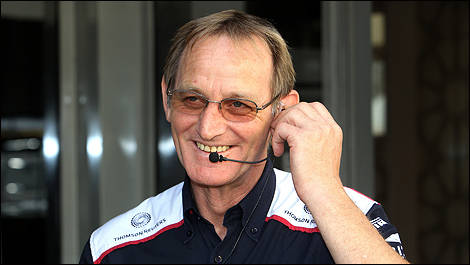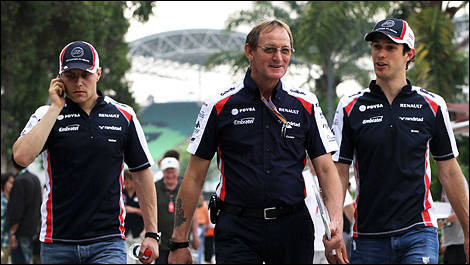Williams’ race and test team manager, Dickie Stanford, is one of the most experienced members of the famous British team, and over three decades, has witnessed some dramatic changes in Formula 1.
Stanford started working in motorsport by helping a friend who was racing Formula Ford in Great Britain.
The young man then climbed the motorsport ladder and finally got his break in Formula 1 after he started working at Williams in 1985.
Subsequently, he has worked with legendary drivers such as Keke Rosberg (not Nico!), Nigel Mansell, Nelson Piquet, Alain Prost and Ayrton Senna.
“When I joined Williams, there were just 80 people in total in the team, this included Frank [Williams] and the cleaners,” he told Auto123.com. “The race team was about 25 people in total, so it’s quite different of the 560 people we have at the moment.
“Formula 1 was completely different back then, as we didn’t have all the electronics that we have today.
“We had the Honda turbo engine and the longitudinal gearbox, but there was no data recording and laptops were only starting to appear.
“We used to sit with the driver,” Stamford recalls. “Then he’d tell you what he thought the car was doing, so we’d then look at the tires, and take it from there. It was more of a mental set-up than an electronic set-up.”
The mid-to-late 1980s were the era of Formula 1’s V6 turbo engines, and enjoyed unlimited boost and ran on “rocket” fuel, as they were enormously powerful but had the tendency to blow into pieces as a result of the frantic pace.
“I think we had 1300 horsepower,” continued Stanford. “Cars were spinning their rear wheels in sixth gear, and in race trim, we had 850-900 horsepower but the rev range was not that big, but the power came in with a bang!
“At a couple of tests with Honda, we tried blanking the waste gate the way BMW was doing in those days, however, Honda found that they could actually manage the power better by not blanking it [the waste gate], but we never raced the FW11 in that configuration¨, he added.
However, tragedy struck the Williams team when Frank Williams sustained a car accident in 1986 in Southern France after a test at the Paul Richard circuit.
“It was pretty devastating for the team because we knew Frank was in a serious condition,” rued Stanford about the accident. “Patrick (Head) and the top executives at Williams - and remember, I was just a mechanic back then - kept it mostly away from the regular team members.
“They gave us just enough information about Frank so we could concentrate on what we were doing.
“Frank was all about racing, so it was up to us to get on with our jobs.
“However, I remember asking myself “is this the end?” The team principal is in serious condition, so what’s going to happen?
“It was the first time that I had to deal with something serious like that and I think the team handled it very well.”
Despite Sir Frank’s absence in the mid to late 1980s, the team always favoured strong headed drivers, such as Mansell, Rosberg and Piquet; men’s men who appear to fit into the team’s ethos of ‘drivers race, engineers engineer’.
“Yes, [they were strongheaded drivers], but they were professional,” recalls Stanford. “Major sponsors were just coming in to F1, so the drivers still had a life of their own.
“Nowadays sponsorship plays such of a role that the drivers have to be careful not offend anybody. Back in the ‘80s, the drivers were more in control of their own time. I remember Keke and Nigel doing very few sponsors events at race meetings, as they were done between races.”
However, after Williams’ championship winning years of the late 1980s and mid-1990s, the manufacturer era of Formula 1, which began in the early 2000s brought unprecedented changes for the Grove based squad.
“Testing for us was the hardest in early 2000 with the BMW engine, as we ran three test cars” Stanford continued. “We ran two test cars at one circuit, and the third one at another track, so for example, we had two cars at Paul Ricard and a third one at let’s say at Monza.
“In the ‘80s, we’d normally do just one big test every two races.”
However, after 28 years, is Dickie Stanford still enjoying working in Formula 1?
Absolutely.
“Every day is a different challenge,” he continues. “No race is the same; no year is the same.
“[There are] different engines, and different bits and pieces on the cars. This is what makes it exciting.
“Additionally, getting some 100 people to each race is a massive challenge these days […] plus the cars and the equipment… there is also 27 tons of air freight and two sea containers to the far away races, then when you come to in Europe, we have four transporters and seven motorhome trucks. It never stops! But I love it!”
The Williams veteran concluded all of this with a big smile.
Stanford started working in motorsport by helping a friend who was racing Formula Ford in Great Britain.
The young man then climbed the motorsport ladder and finally got his break in Formula 1 after he started working at Williams in 1985.
 |
| Mansell and Piquet's FW11-Hondas at Silverstone in 1986. Dickie Stanford is leaning against Mansell's rear left tire. (Photo: WRI2) |
Subsequently, he has worked with legendary drivers such as Keke Rosberg (not Nico!), Nigel Mansell, Nelson Piquet, Alain Prost and Ayrton Senna.
“When I joined Williams, there were just 80 people in total in the team, this included Frank [Williams] and the cleaners,” he told Auto123.com. “The race team was about 25 people in total, so it’s quite different of the 560 people we have at the moment.
“Formula 1 was completely different back then, as we didn’t have all the electronics that we have today.
“We had the Honda turbo engine and the longitudinal gearbox, but there was no data recording and laptops were only starting to appear.
“We used to sit with the driver,” Stamford recalls. “Then he’d tell you what he thought the car was doing, so we’d then look at the tires, and take it from there. It was more of a mental set-up than an electronic set-up.”
The mid-to-late 1980s were the era of Formula 1’s V6 turbo engines, and enjoyed unlimited boost and ran on “rocket” fuel, as they were enormously powerful but had the tendency to blow into pieces as a result of the frantic pace.
 |
| Dickie Stanford (Photo: WRI2) |
“I think we had 1300 horsepower,” continued Stanford. “Cars were spinning their rear wheels in sixth gear, and in race trim, we had 850-900 horsepower but the rev range was not that big, but the power came in with a bang!
“At a couple of tests with Honda, we tried blanking the waste gate the way BMW was doing in those days, however, Honda found that they could actually manage the power better by not blanking it [the waste gate], but we never raced the FW11 in that configuration¨, he added.
However, tragedy struck the Williams team when Frank Williams sustained a car accident in 1986 in Southern France after a test at the Paul Richard circuit.
“It was pretty devastating for the team because we knew Frank was in a serious condition,” rued Stanford about the accident. “Patrick (Head) and the top executives at Williams - and remember, I was just a mechanic back then - kept it mostly away from the regular team members.
“They gave us just enough information about Frank so we could concentrate on what we were doing.
“Frank was all about racing, so it was up to us to get on with our jobs.
“However, I remember asking myself “is this the end?” The team principal is in serious condition, so what’s going to happen?
“It was the first time that I had to deal with something serious like that and I think the team handled it very well.”
Despite Sir Frank’s absence in the mid to late 1980s, the team always favoured strong headed drivers, such as Mansell, Rosberg and Piquet; men’s men who appear to fit into the team’s ethos of ‘drivers race, engineers engineer’.
“Yes, [they were strongheaded drivers], but they were professional,” recalls Stanford. “Major sponsors were just coming in to F1, so the drivers still had a life of their own.
“Nowadays sponsorship plays such of a role that the drivers have to be careful not offend anybody. Back in the ‘80s, the drivers were more in control of their own time. I remember Keke and Nigel doing very few sponsors events at race meetings, as they were done between races.”
 |
| Dickie Stanford with Williams drivers Valtteri Bottas (left) and Bruno Senna (right).(Photo: WRI2) |
However, after Williams’ championship winning years of the late 1980s and mid-1990s, the manufacturer era of Formula 1, which began in the early 2000s brought unprecedented changes for the Grove based squad.
“Testing for us was the hardest in early 2000 with the BMW engine, as we ran three test cars” Stanford continued. “We ran two test cars at one circuit, and the third one at another track, so for example, we had two cars at Paul Ricard and a third one at let’s say at Monza.
“In the ‘80s, we’d normally do just one big test every two races.”
However, after 28 years, is Dickie Stanford still enjoying working in Formula 1?
Absolutely.
“Every day is a different challenge,” he continues. “No race is the same; no year is the same.
“[There are] different engines, and different bits and pieces on the cars. This is what makes it exciting.
“Additionally, getting some 100 people to each race is a massive challenge these days […] plus the cars and the equipment… there is also 27 tons of air freight and two sea containers to the far away races, then when you come to in Europe, we have four transporters and seven motorhome trucks. It never stops! But I love it!”
The Williams veteran concluded all of this with a big smile.


